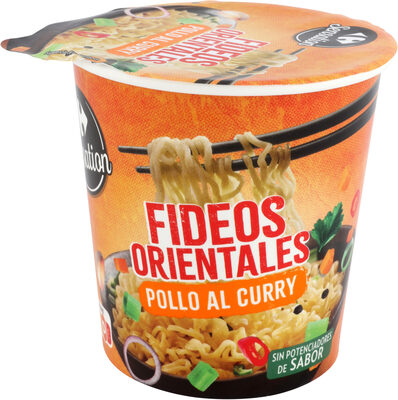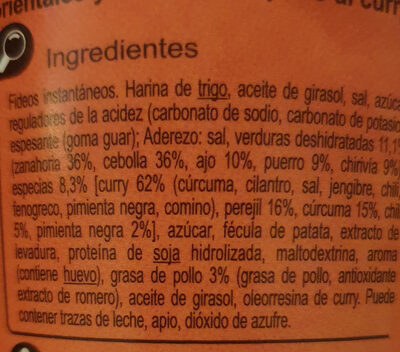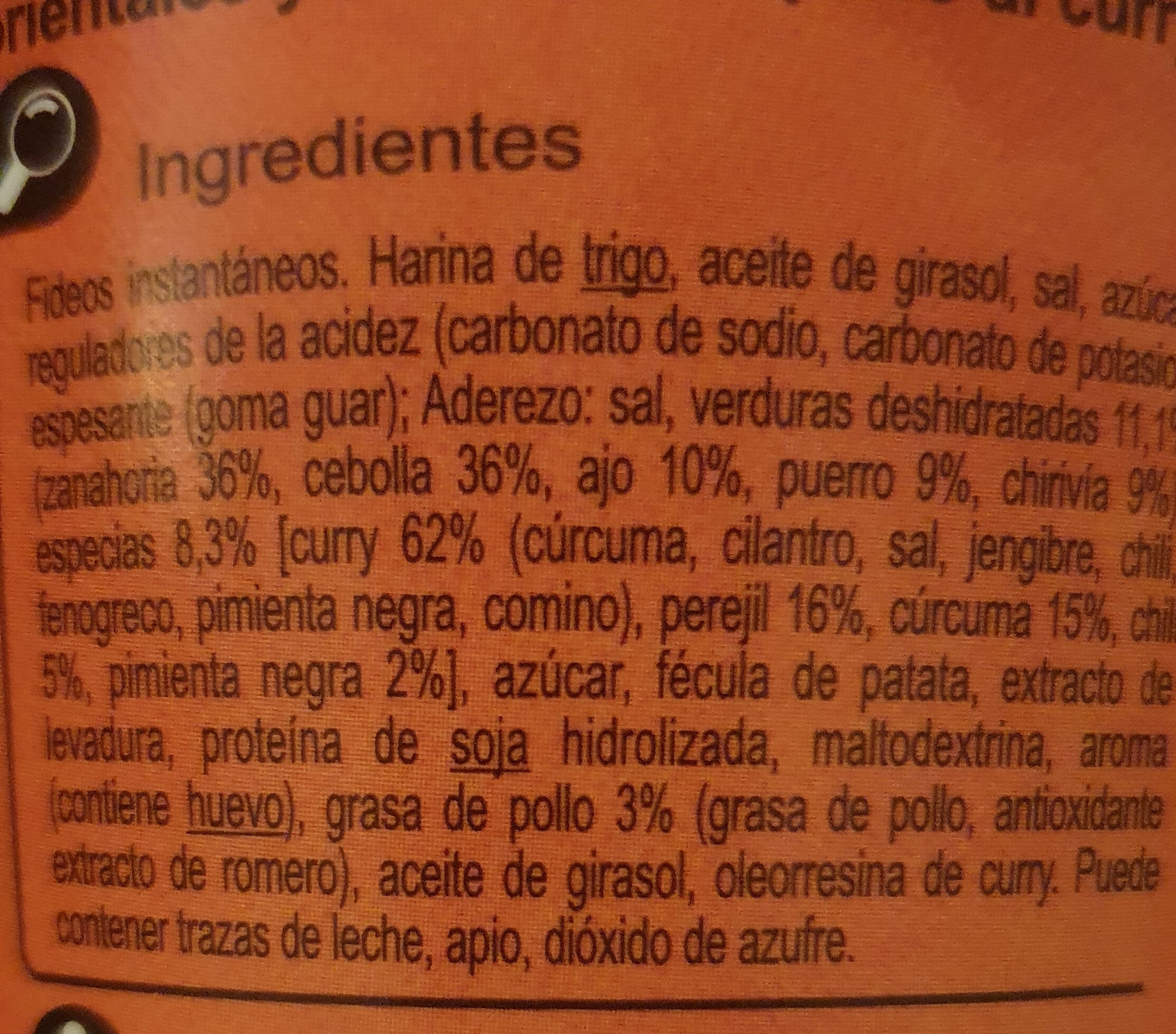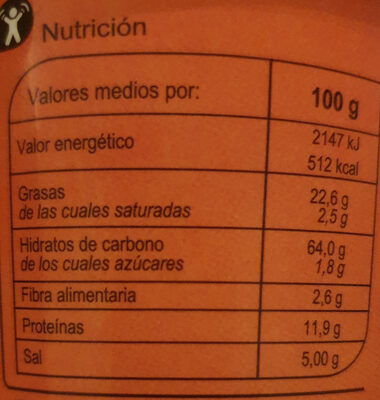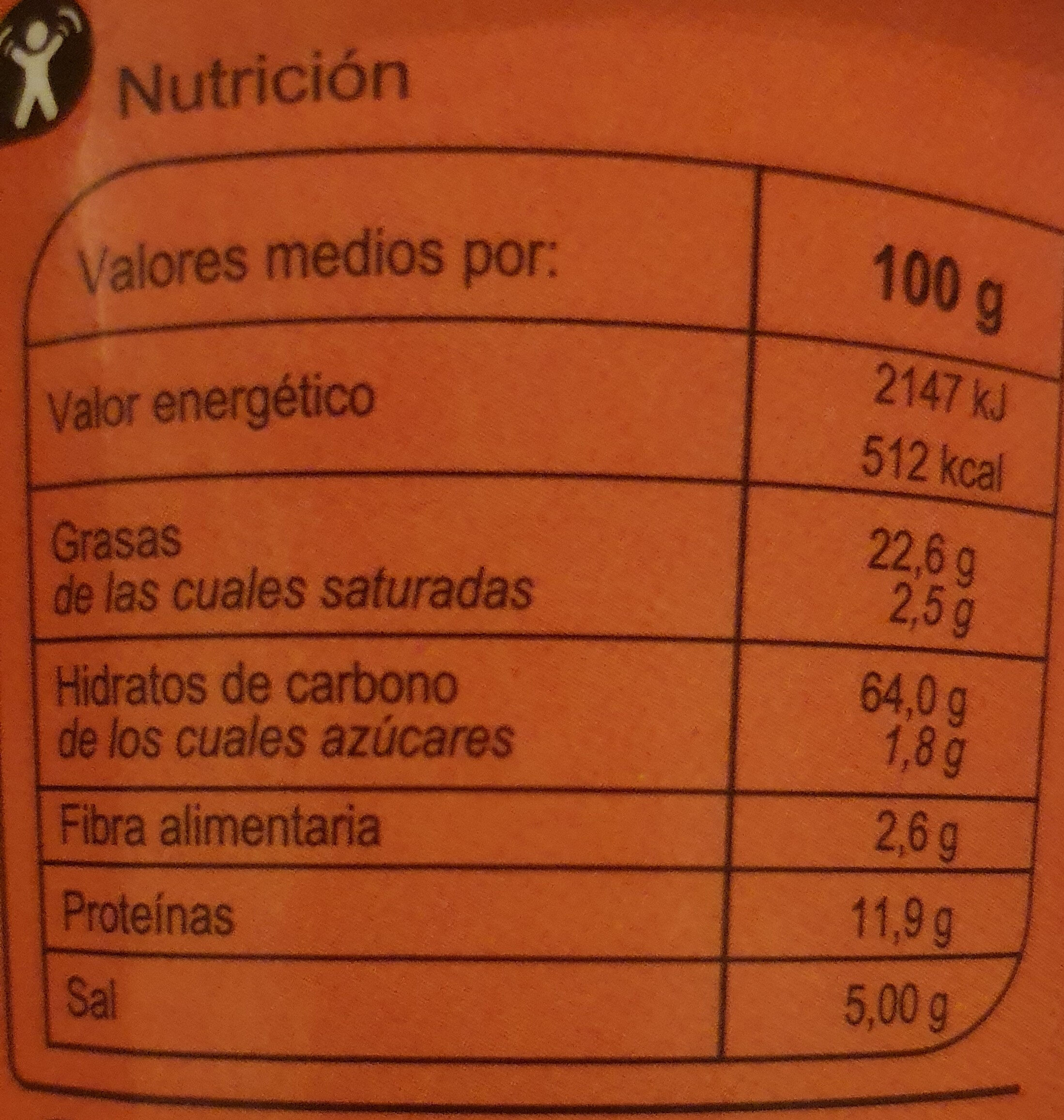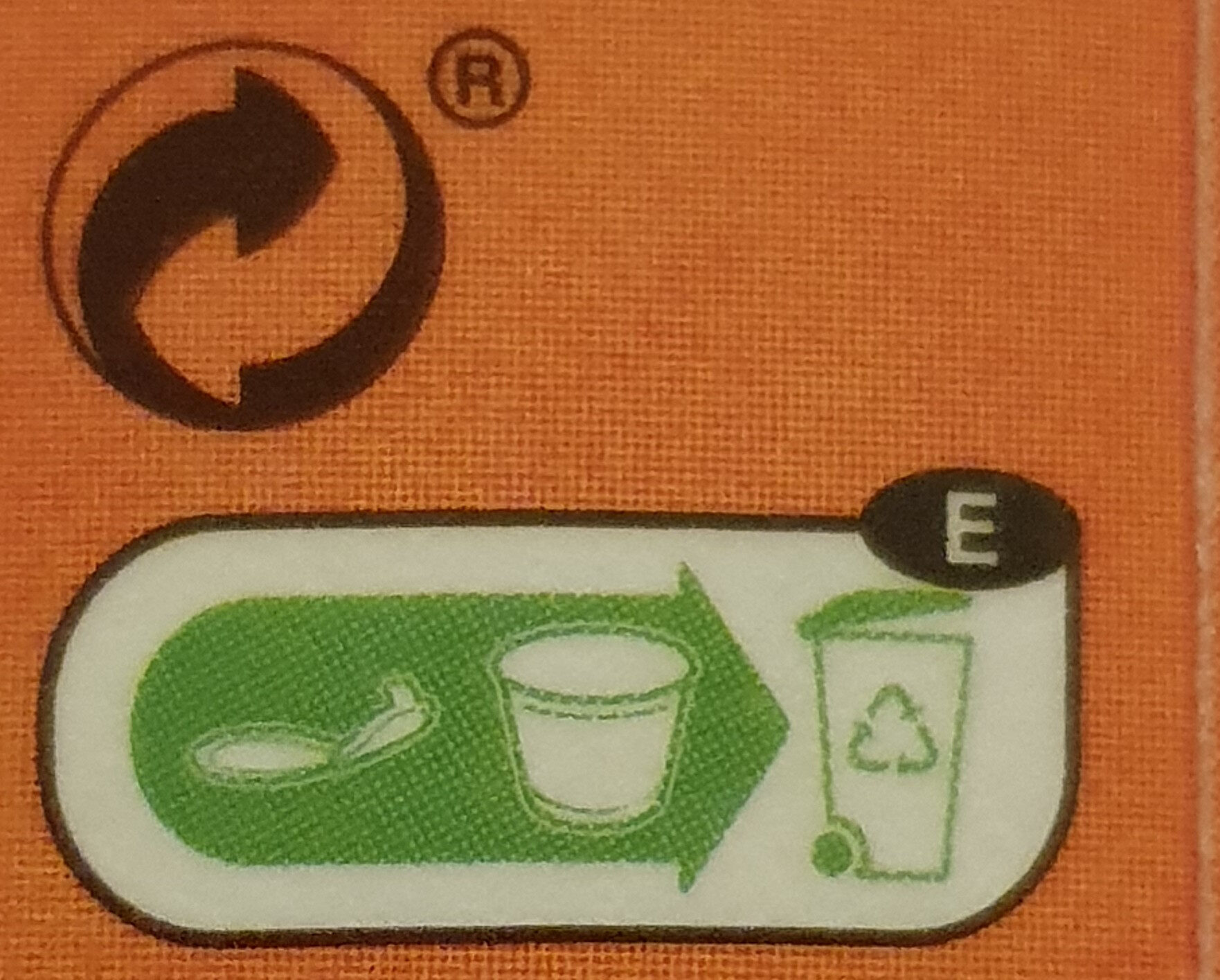Help us make food transparency the norm!
As a non-profit organization, we depend on your donations to continue informing consumers around the world about what they eat.
The food revolution starts with you!
Noodles pollo al curry - Carrefour - 65g
Noodles pollo al curry - Carrefour - 65g
Some of the data for this product has been provided directly by the manufacturer Carrefour España.
Barra-kodea: 8431876296563 (EAN / EAN-13)
Kopurua: 65g
Ontziratzea: en:Plastic, en:container
Markak: Carrefour
Kategoriak: en:Plant-based foods and beverages, en:Plant-based foods, en:Cereals and potatoes, en:Cereals and their products, en:Meals, en:Dried products, Pasta, en:Dried products to be rehydrated, en:Noodles, en:Soups, en:Instant noodles, en:Chinese noodles, en:Tagliatelle
Etiketak, ziurtagiriak, sariak: en:Organic
Origin of ingredients: Espainia
Manufacturing or processing places: España
Dendak: Carrefour
Saltzen diren herrialdeak: Espainia
Matching with your preferences
Health
Osagaiak
-
43 ingredients
: Harina de trigo, aceite de girasol, sal, azúcar, reguladores de la acidez (carbonato de sodio, carbonato de potasio), espesante (goma guar); Aderezo: sal, verduras deshidratdas 11,1% (zanahoria 36%, cebolla 36%, ajo 10%, puerro 9%, chirivía 9%), especias 8,3% [curry 62% (cúrcuma, cilantro, sal, jengibre, chili, fenogreco, pimienta negra, comino), perejil 16%, cúrcuma 15%, chili 5%, pimienta negra 2%], azúcar, fécula de patata, extracto de levadura, proteína de soja hidrolizada, maltodextrina, aroma (contiene huevo), grasa de pollo 3% (grasa de pollo, antioxidante extracto de romero), aceite de girasol, oleorresina de curry.Alergenoak: en:Eggs, en:Gluten, en:SoybeansAztarnak: en:Celery, en:Eggs, en:Gluten, en:Milk, en:Soybeans, en:Sulphur dioxide and sulphites
Food processing
-
Ultra processed foods
Elements that indicate the product is in the 4 - Ultra prozesatutako elikagaiak eta edariak group:
- Gehigarria: E412
- Osagaia: Flavouring
- Osagaia: Maltodextrin
- Osagaia: Thickener
Food products are classified into 4 groups according to their degree of processing:
- Prozesatu gabeko edo ahalik eta gutxien prozesatutako elikagaiak
- Sukaldaritzako osagaiak prozesatu
- Prozesatutako jakiak
- Ultra processed foods
The determination of the group is based on the category of the product and on the ingredients it contains.
Gehigarriak
-
E412
Guar gum: Guar gum, also called guaran, is a galactomannan polysaccharide extracted from guar beans that has thickening and stabilizing properties useful in the food, feed and industrial applications. The guar seeds are mechanically dehusked, hydrated, milled and screened according to application. It is typically produced as a free-flowing, off-white powder.Source: Wikipedia (Ingeles)
-
E500
Sodium carbonate: Sodium carbonate, Na2CO3, -also known as washing soda, soda ash and soda crystals, and in the monohydrate form as crystal carbonate- is the water-soluble sodium salt of carbonic acid. It most commonly occurs as a crystalline decahydrate, which readily effloresces to form a white powder, the monohydrate. Pure sodium carbonate is a white, odorless powder that is hygroscopic -absorbs moisture from the air-. It has a strongly alkaline taste, and forms a moderately basic solution in water. Sodium carbonate is well known domestically for its everyday use as a water softener. Historically it was extracted from the ashes of plants growing in sodium-rich soils, such as vegetation from the Middle East, kelp from Scotland and seaweed from Spain. Because the ashes of these sodium-rich plants were noticeably different from ashes of timber -used to create potash-, they became known as "soda ash". It is synthetically produced in large quantities from salt -sodium chloride- and limestone by a method known as the Solvay process. The manufacture of glass is one of the most important uses of sodium carbonate. Sodium carbonate acts as a flux for silica, lowering the melting point of the mixture to something achievable without special materials. This "soda glass" is mildly water-soluble, so some calcium carbonate is added to the melt mixture to make the glass produced insoluble. This type of glass is known as soda lime glass: "soda" for the sodium carbonate and "lime" for the calcium carbonate. Soda lime glass has been the most common form of glass for centuries. Sodium carbonate is also used as a relatively strong base in various settings. For example, it is used as a pH regulator to maintain stable alkaline conditions necessary for the action of the majority of photographic film developing agents. It acts as an alkali because when dissolved in water, it dissociates into the weak acid: carbonic acid and the strong alkali: sodium hydroxide. This gives sodium carbonate in solution the ability to attack metals such as aluminium with the release of hydrogen gas.It is a common additive in swimming pools used to raise the pH which can be lowered by chlorine tablets and other additives which contain acids. In cooking, it is sometimes used in place of sodium hydroxide for lyeing, especially with German pretzels and lye rolls. These dishes are treated with a solution of an alkaline substance to change the pH of the surface of the food and improve browning. In taxidermy, sodium carbonate added to boiling water will remove flesh from the bones of animal carcasses for trophy mounting or educational display. In chemistry, it is often used as an electrolyte. Electrolytes are usually salt-based, and sodium carbonate acts as a very good conductor in the process of electrolysis. In addition, unlike chloride ions, which form chlorine gas, carbonate ions are not corrosive to the anodes. It is also used as a primary standard for acid-base titrations because it is solid and air-stable, making it easy to weigh accurately.Source: Wikipedia (Ingeles)
-
E500i
Sodium carbonate: Sodium carbonate, Na2CO3, -also known as washing soda, soda ash and soda crystals, and in the monohydrate form as crystal carbonate- is the water-soluble sodium salt of carbonic acid. It most commonly occurs as a crystalline decahydrate, which readily effloresces to form a white powder, the monohydrate. Pure sodium carbonate is a white, odorless powder that is hygroscopic -absorbs moisture from the air-. It has a strongly alkaline taste, and forms a moderately basic solution in water. Sodium carbonate is well known domestically for its everyday use as a water softener. Historically it was extracted from the ashes of plants growing in sodium-rich soils, such as vegetation from the Middle East, kelp from Scotland and seaweed from Spain. Because the ashes of these sodium-rich plants were noticeably different from ashes of timber -used to create potash-, they became known as "soda ash". It is synthetically produced in large quantities from salt -sodium chloride- and limestone by a method known as the Solvay process. The manufacture of glass is one of the most important uses of sodium carbonate. Sodium carbonate acts as a flux for silica, lowering the melting point of the mixture to something achievable without special materials. This "soda glass" is mildly water-soluble, so some calcium carbonate is added to the melt mixture to make the glass produced insoluble. This type of glass is known as soda lime glass: "soda" for the sodium carbonate and "lime" for the calcium carbonate. Soda lime glass has been the most common form of glass for centuries. Sodium carbonate is also used as a relatively strong base in various settings. For example, it is used as a pH regulator to maintain stable alkaline conditions necessary for the action of the majority of photographic film developing agents. It acts as an alkali because when dissolved in water, it dissociates into the weak acid: carbonic acid and the strong alkali: sodium hydroxide. This gives sodium carbonate in solution the ability to attack metals such as aluminium with the release of hydrogen gas.It is a common additive in swimming pools used to raise the pH which can be lowered by chlorine tablets and other additives which contain acids. In cooking, it is sometimes used in place of sodium hydroxide for lyeing, especially with German pretzels and lye rolls. These dishes are treated with a solution of an alkaline substance to change the pH of the surface of the food and improve browning. In taxidermy, sodium carbonate added to boiling water will remove flesh from the bones of animal carcasses for trophy mounting or educational display. In chemistry, it is often used as an electrolyte. Electrolytes are usually salt-based, and sodium carbonate acts as a very good conductor in the process of electrolysis. In addition, unlike chloride ions, which form chlorine gas, carbonate ions are not corrosive to the anodes. It is also used as a primary standard for acid-base titrations because it is solid and air-stable, making it easy to weigh accurately.Source: Wikipedia (Ingeles)
-
E501
Potassium carbonate: Potassium carbonate -K2CO3- is a white salt, which is soluble in water -insoluble in ethanol- and forms a strongly alkaline solution. It can be made as the product of potassium hydroxide's absorbent reaction with carbon dioxide. It is deliquescent, often appearing a damp or wet solid. Potassium carbonate is used in the production of soap and glass.Source: Wikipedia (Ingeles)
-
E501i
Potassium carbonate: Potassium carbonate -K2CO3- is a white salt, which is soluble in water -insoluble in ethanol- and forms a strongly alkaline solution. It can be made as the product of potassium hydroxide's absorbent reaction with carbon dioxide. It is deliquescent, often appearing a damp or wet solid. Potassium carbonate is used in the production of soap and glass.Source: Wikipedia (Ingeles)
Ingredients analysis
-
en:May contain palm oil
Ingredients that may contain palm oil: en:Chicken fat
-
en:Non-vegan
Non-vegan ingredients: en:Chicken fat, en:Chicken fatSome ingredients could not be recognized.
We need your help!
You can help us recognize more ingredients and better analyze the list of ingredients for this product and others:
- Edit this product page to correct spelling mistakes in the ingredients list, and/or to remove ingredients in other languages and sentences that are not related to the ingredients.
- Add new entries, synonyms or translations to our multilingual lists of ingredients, ingredient processing methods, and labels.
If you would like to help, join the #ingredients channel on our Slack discussion space and/or learn about ingredients analysis on our wiki. Thank you!
-
en:Non-vegetarian
Non-vegetarian ingredients: en:Chicken fat, en:Chicken fatSome ingredients could not be recognized.
We need your help!
You can help us recognize more ingredients and better analyze the list of ingredients for this product and others:
- Edit this product page to correct spelling mistakes in the ingredients list, and/or to remove ingredients in other languages and sentences that are not related to the ingredients.
- Add new entries, synonyms or translations to our multilingual lists of ingredients, ingredient processing methods, and labels.
If you would like to help, join the #ingredients channel on our Slack discussion space and/or learn about ingredients analysis on our wiki. Thank you!
-
Details of the analysis of the ingredients
We need your help!
Some ingredients could not be recognized.
We need your help!
You can help us recognize more ingredients and better analyze the list of ingredients for this product and others:
- Edit this product page to correct spelling mistakes in the ingredients list, and/or to remove ingredients in other languages and sentences that are not related to the ingredients.
- Add new entries, synonyms or translations to our multilingual lists of ingredients, ingredient processing methods, and labels.
If you would like to help, join the #ingredients channel on our Slack discussion space and/or learn about ingredients analysis on our wiki. Thank you!
: Harina de trigo, aceite de girasol, sal, azúcar, reguladores de la acidez (carbonato de sodio, carbonato de potasio), espesante (goma guar), Aderezo (sal), verduras deshidratdas 11.1% (zanahoria 36%, cebolla 36%, ajo 10%, puerro 9%, chirivía 9%), especias 8.3% (curry 62% (cúrcuma, cilantro, sal, jengibre, chili, fenogreco, pimienta negra, comino), perejil 16%, cúrcuma 15%, chili 5%, pimienta negra 2%), azúcar, fécula de patata, extracto de levadura, proteína de soja hidrolizada, maltodextrina, aroma, grasa de pollo 3% (grasa de pollo, antioxidante (extracto de romero)), aceite de girasol, oleorresina de curry- Harina de trigo -> en:wheat-flour - vegan: yes - vegetarian: yes - ciqual_proxy_food_code: 9410
- aceite de girasol -> en:sunflower-oil - vegan: yes - vegetarian: yes - from_palm_oil: no - ciqual_food_code: 17440
- sal -> en:salt - vegan: yes - vegetarian: yes - ciqual_food_code: 11058
- azúcar -> en:sugar - vegan: yes - vegetarian: yes - ciqual_proxy_food_code: 31016
- reguladores de la acidez -> en:acidity-regulator
- carbonato de sodio -> en:e500i - vegan: yes - vegetarian: yes
- carbonato de potasio -> en:e501i - vegan: yes - vegetarian: yes
- espesante -> en:thickener
- goma guar -> en:e412 - vegan: yes - vegetarian: yes
- Aderezo -> es:aderezo
- sal -> en:salt - vegan: yes - vegetarian: yes - ciqual_food_code: 11058
- verduras deshidratdas -> es:verduras-deshidratdas - percent: 11.1
- zanahoria -> en:carrot - vegan: yes - vegetarian: yes - ciqual_food_code: 20009 - percent: 36
- cebolla -> en:onion - vegan: yes - vegetarian: yes - ciqual_food_code: 20034 - percent: 36
- ajo -> en:garlic - vegan: yes - vegetarian: yes - ciqual_food_code: 11000 - percent: 10
- puerro -> en:leek - vegan: yes - vegetarian: yes - ciqual_food_code: 20039 - percent: 9
- chirivía -> en:parsnip - vegan: yes - vegetarian: yes - ciqual_food_code: 20181 - percent: 9
- especias -> en:spice - vegan: yes - vegetarian: yes - percent: 8.3
- curry -> en:curry - vegan: yes - vegetarian: yes - ciqual_food_code: 11005 - percent: 62
- cúrcuma -> en:turmeric - vegan: yes - vegetarian: yes - ciqual_proxy_food_code: 11089
- cilantro -> en:coriander - vegan: yes - vegetarian: yes
- sal -> en:salt - vegan: yes - vegetarian: yes - ciqual_food_code: 11058
- jengibre -> en:ginger - vegan: yes - vegetarian: yes - ciqual_food_code: 11074
- chili -> en:chili-pepper - vegan: yes - vegetarian: yes - ciqual_food_code: 20151
- fenogreco -> en:fenugreek - vegan: yes - vegetarian: yes
- pimienta negra -> en:black-pepper - vegan: yes - vegetarian: yes - ciqual_food_code: 11015
- comino -> en:cumin - vegan: yes - vegetarian: yes
- perejil -> en:parsley - vegan: yes - vegetarian: yes - ciqual_proxy_food_code: 11014 - percent: 16
- cúrcuma -> en:turmeric - vegan: yes - vegetarian: yes - ciqual_proxy_food_code: 11089 - percent: 15
- chili -> en:chili-pepper - vegan: yes - vegetarian: yes - ciqual_food_code: 20151 - percent: 5
- pimienta negra -> en:black-pepper - vegan: yes - vegetarian: yes - ciqual_food_code: 11015 - percent: 2
- curry -> en:curry - vegan: yes - vegetarian: yes - ciqual_food_code: 11005 - percent: 62
- azúcar -> en:sugar - vegan: yes - vegetarian: yes - ciqual_proxy_food_code: 31016
- fécula de patata -> en:potato-starch - vegan: yes - vegetarian: yes - ciqual_proxy_food_code: 9510
- extracto de levadura -> en:yeast-extract - vegan: yes - vegetarian: yes
- proteína de soja hidrolizada -> en:hydrolysed-soy-protein - vegan: yes - vegetarian: yes - ciqual_food_code: 20591
- maltodextrina -> en:maltodextrin - vegan: yes - vegetarian: yes
- aroma -> en:flavouring - vegan: maybe - vegetarian: maybe
- grasa de pollo -> en:chicken-fat - vegan: no - vegetarian: no - from_palm_oil: maybe - ciqual_food_code: 16540 - percent: 3
- grasa de pollo -> en:chicken-fat - vegan: no - vegetarian: no - from_palm_oil: maybe - ciqual_food_code: 16540
- antioxidante -> en:antioxidant
- extracto de romero -> en:e392 - vegan: yes - vegetarian: yes
- aceite de girasol -> en:sunflower-oil - vegan: yes - vegetarian: yes - from_palm_oil: no - ciqual_food_code: 17440
- oleorresina de curry -> es:oleorresina-de-curry
-
Nutrition facts
Nutrition facts As sold
for 100 g / 100 mlAs sold
per serving (65g)Compared to: en:Chinese noodles Energia 2.147 kj
(512 kcal)1.400 kj
(333 kcal)+% 136 Koipe 22,6 g 14,7 g +% 611 Gantz-azido ase 2,5 g 1,62 g +% 127 Carbohydrates 64 g 41,6 g +% 65 Azukre 1,8 g 1,17 g +% 29 Fiber 2,6 g 1,69 g +% 66 Proteina 11,9 g 7,74 g +% 111 Gatz arrunt 5 g 3,25 g +% 488 Fruits‚ vegetables‚ nuts and rapeseed‚ walnut and olive oils 0 % 0 % Fruits‚ vegetables‚ nuts and rapeseed‚ walnut and olive oils (estimate from ingredients list analysis) 121 % 121 %
Ingurumena
-
Eco-Score B - Ingurumen-eragin txikia
The Eco-Score is an experimental score that summarizes the environmental impacts of food products.→ The Eco-Score was initially developped for France and it is being extended to other European countries. The Eco-Score formula is subject to change as it is regularly improved to make it more precise and better suited to each country.Life cycle analysis
-
Average impact of products of the same category: A (Score: 82/100)
Kategoria: Asian noodles, flavoured, dehydrated
Kategoria: Asian noodles, flavoured, dehydrated
- PEF environmental score: 0.26 (the lower the score, the lower the impact)
- including impact on climate change: 1.67 kg CO2 eq/kg of product
Stage Impact Agriculture
65.5 %Processing
20.6 %Ontziratzea
8.7 %Transportation
3.5 %Distribution
1.8 %Consumption
0.0 %
Bonuses and maluses
-
Origins of ingredients with a low impact
Bonus: +18
Environmental policy: +3
Transportation: +15
Origin of the product and/or its ingredients % of ingredients Impact Espainia 100 %Baxua
-
Packaging with a medium impact
Malus: -10
Shape Material Recycling Impact container Plastic Altua ⚠ ️ The information about the packaging of this product is not sufficiently precise (exact shapes and materials of all components of the packaging).⚠ ️ For a more precise calculation of the Eco-Score, you can modify the product page and add them.
If you are the manufacturer of this product, you can send us the information with our free platform for producers.
Eco-Score for this product
-
Impact for this product: B (Score: 79/100)
Produktua: Noodles pollo al curry - Carrefour - 65g
Life cycle analysis score: 82
Sum of bonuses and maluses: +8
Final score: 79/100 (The score of products with non-recyclable and non-biodegradable packaging materials is capped at 79 (grade B).)
-
Carbon footprint
-
Equal to driving 0.9 km in a petrol car
167 g CO² per 100g of product
The carbon emission figure comes from ADEME's Agribalyse database, for the category: Asian noodles, flavoured, dehydrated (Source: ADEME Agribalyse Database)
Stage Impact Agriculture
61.0 %Processing
14.9 %Ontziratzea
16.3 %Transportation
6.8 %Distribution
1.0 %Consumption
0.0 %
Ontziratzea
-
Packaging with a medium impact
-
Packaging parts
container (Plastic)
-
Bilgarriaren materialak
Material % Bilgarriaren pisua Bilgarriaren pisua produktuaren 100g-ko Plastic
-
Transportation
-
Origins of ingredients
Origins of ingredients with a low impact
Origin of the product and/or its ingredients % of ingredients Impact Espainia 100 %Baxua
Report a problem
-
Incomplete or incorrect information?
Category, labels, ingredients, allergens, nutritional information, photos etc.
If the information does not match the information on the packaging, please complete or correct it. Open Food Facts is a collaborative database, and every contribution is useful for all.
Datuen iturria
Product added on by johnlon
Last edit of product page on by packbot.
Produktuaren orria -gatik editatua ecoscore-impact-estimator, openfoodfacts-contributors, org-carrefour-espana.
